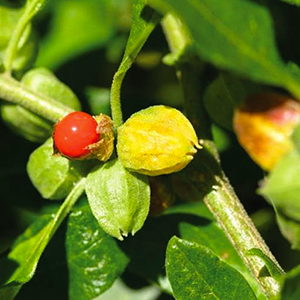The root and berry of the Ashwaganda plant have been used to make medicine for thousands of years.
The Ashwagandha plant is described by many names: Ajagandha, Amangura, Amukkirag, Asan, Asana, Asgand, Asgandh, Asgandha, Ashagandha, Ashvagandha, Ashwaganda, Ashwanga, Asoda, Asundha, Asvagandha, Aswagandha, Avarada, Ayurvedic Ginseng, Cerise d'Hiver, Clustered Wintercherry, Ghoda Asoda, Ginseng Ayurvédique, Ginseng Indien, Hayahvaya, Indian Ginseng, Kanaje Hindi, Kuthmithi, Orovale, Peyette, Physalis somnifera, Samm Al Ferakh, Samm Al Rerakh, Sogade-Beru, Strychnos, Turangi-Ghanda, Vajigandha, Winter Cherry, Withania, Withania somnifera(1). It has been used for arthritis, anxiety, trouble sleeping (insomnia), tumors, tuberculosis, asthma, leukoderma (a skin condition marked by white patchiness), bronchitis, backache, fibromyalgia, menstrual problems, hiccups, and chronic liver disease(1).
Studies indicate WS possesses anti-inflammatory, antitumor, antistress, antioxidant, immunomodulatory, hemopoetic, and rejuvenating properties. It also appears to exert a positive influence on the endocrine, cardiopulmonary, and central nervous systems. The endocrine system consists of glands that produce and secrete hormones, chemical substances produced in the body that regulate the activity of cells or organs. The cardiovascular system consists of the heart, blood vessels, and blood, and transports nutrients, oxygen, and hormones to cells throughout the body and removes metabolic wastes. The central nervous system consists of the brain and the spinal cord and send signals between the brain, spinal cord, and other body organs via nerve impulses.
Roots of WS are the main portions of the plant used therapeutically. The dried roots are found to be useful in the treatment of nervous and sexual disorders. The biological activity of WS extract have showed antioxidant and free radical scavenging potential. Additionally, WS is a potent neuronal tonic and has been expected to be used in the treatment of many neurological deficits including epilepsy, poor memory, depression and Parkinson’s Disease in animal model(4).
Withania somnifera (WS) possesses multiple pharmacological properties which are mainly accredited to the withanolides, its active constituents. Medicinally, Ws root extract is known to possess anti-aging, anti-oxidant and anti-cancerous properties. Telomerase activity and short telomeres are implicated in aging mechanism. Enhancing telomerase activity is one way to delay aging by enhancing telomerase activity(6). Sitoindosides VII–X and Withaferin-A, the two active principles of Ashwagandha, have been shown to have significant anti-stress activity, and to exhibit strong anti-oxidant activity in rat model(4). WS caused inhibition of proliferation and invasion of breast cancer cells in culture and growth of xenografted cancer cells in mice(5). Withaferin-A was also found to promote cell death in prostate cancer cells but not normal fibroblasts, the most common cells of connective tissue in animals(7).
Toxicity studies reveal that ashwagandha appears to be a safe compound(3). Ashwagandha is reported to promote increased production of all stem cells. One study done to evaluate the potential toxicity of Withania somnifera and Panax ginseng when given together not only found that there was no toxicity, but that hematopoiesis was improved(2).
General:
1WebMD. Find a vitamin or supplement: Ashwagandha. (2005-2016). http://www.webmd.com/vitamins-supplements/ingredientmono-953-ashwagandha.aspx?activeingredientid=953
3)Mishra LC, Singh BB, Dagenais S. Scientific basis for the therapeutic use of Withania somnifera (ashwagandha): a review. Alternative medicine review. 2000 Aug 1;5(4):334-46. http://kevaind.org/download/Withania%20somnifera%20in%20Thyroid.pdf
Liver and Kidney:
Akbarsha, M. A., Vijendrakumar, S., Kadalmani, B., Girija, R., and Faridha, A. Curative property of Withania somnifera Dunal root in the context of carbendazim-induced histopathological changes in the liver and kidney of rat. Phytomedicine 2000;7(6):499-507. http://www.academia.edu/download/41201795/02e7e5294789213320000000.pdf20160115-19908-1t08cnl.pdf
Anti-inflamatory:
al Hindawi, M. K., al Khafaji, S. H., and Abdul-Nabi, M. H. Anti-granuloma activity of Iraqi Withania somnifera. J Ethnopharmacol. 1992;37(2):113-116. View abstract. http://www.sciencedirect.com/science/article/pii/0378874192900694
Anbalagan K and Sadique J. Withania somnifera (ashwagandha), a rejuvenating herbal drug which controls alpha-2 macroglobulin synthesis during inflammation. Int.J.Crude Drug Res. 1985;23(4):177-183. View abstract. http://www.tandfonline.com/doi/abs/10.3109/13880208509069028
2)Aphale, A. A., Chhibba, A. D., Kumbhakarna, N. R., Mateenuddin, M., and Dahat, S. H. Subacute toxicity study of the combination of ginseng (Panax ginseng) and ashwagandha (Withania somnifera) in rats: a safety assessment. Indian J Physiol Pharmacol. 1998;42(2):299-302. http://www.ijpp.com/IJPP%20archives/1998_42_2/299-302.pdf
Cancer:
Szarc vel Szic K, Op de Beeck K, Ratman D, Wouters A, Beck IM, Declerck K, et al. (2014) Pharmacological Levels of Withaferin A (Withania somnifera) Trigger Clinically Relevant Anticancer Effects Specific to Triple Negative Breast Cancer Cells. PLoS ONE 9(2): e87850. doi:10.1371/journal.pone.0087850 http://journals.plos.org/plosone/article?id=10.1371/journal.pone.0087850
5)Khazal, K. F., et al. "Abstract P6-09-08: Withania somnifera extract inhibits invasion and metastasis of MDA-MB-231 cells by inhibiting CCL2 and CD44 high/CD24low stem cells." Cancer Research 73.24 Supplement (2013): P6-09.
7)Nishikawa Y, Okuzaki D, Fukushima K, Mukai S, Ohno S, Ozaki Y, et al. (2015) Withaferin A Induces Cell Death Selectively in Androgen-Independent Prostate Cancer Cells but Not in Normal Fibroblast Cells. PLoS ONE 10(7): e0134137. doi:10.1371/journal.pone.0134137 http://journals.plos.org/plosone/article?id=10.1371/journal.pone.0134137
Parkinson’s Disease:
4)Singh N, Rai SN, Singh D, Singh SP (2015) Withania somnifera shows ability to counter Parkinson's Disease: An Update. SOJ Neurol 2(2), 1-4. http://www.symbiosisonlinepublishing.com/neurology/neurology20.php
Anti-Aging:
6)Raguraman, V. and Subramaniam, J. (2016) Withania somnifera Root Extract Enhances Telomerase Activity in the Human HeLa Cell Line. Advances in Bioscience and Biotechnology, 7, 199-204. doi: 10.4236/abb.2016.74018.
